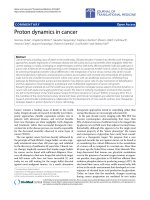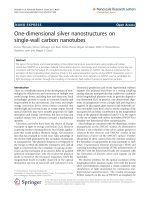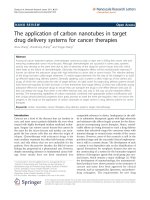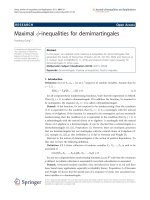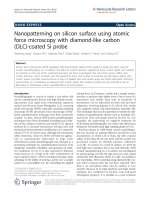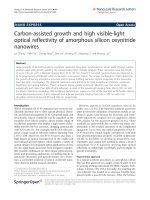Báo cáo hóa học: " Silicon Encapsulated Carbon Nanotubes" pdf
Bạn đang xem bản rút gọn của tài liệu. Xem và tải ngay bản đầy đủ của tài liệu tại đây (449.82 KB, 7 trang )
NANO EXPRESS
Silicon Encapsulated Carbon Nanotubes
Sri Lakshmi Katar
•
Azlin Biaggi Labiosa
•
Amairy E. Plaud
•
Edgar Mosquera-Vargas
•
Luis Fonseca
•
Brad R. Weiner
•
Gerardo Morell
Received: 25 May 2009 / Accepted: 24 September 2009 / Published online: 9 October 2009
Ó to the authors 2009
Abstract A dual stage process of depositing bamboo-like
carbon nanotubes (BCNTs) by hot filament chemical vapor
deposition (HFCVD) and coating Si using Radio frequency
sputtering (RFS) technique. The films were characterized by
scanning electron microscopy (SEM), transmission electron
microscopy (TEM), Raman spectroscopy, X-ray photo-
electron spectroscopy (XPS), and electron field emission
studies (EFE). SEM results suggest a dense network of
homogeneous silicon-coated BCNTs. From the compre-
hensive analysis of the results provided by these techniques
emerges the picture of Si encapsulated BCNTs.
Keywords BCNTs Á Silicon coated Á Sputtering
Introduction
Silicon is an important material due to its role as the fun-
damental component in integrated circuits, microelectron-
ics, and in lithium ion batteries. Continuous efforts have
been focused on investigating the nanostructures of silicon
for unveiling the properties and miniaturizing the micro-
electronics devices, including the goal of integrating the
electronics and photonics on the same Si chip. To attain this
challenge various groups reported silicon nanotubes, each
using a different growth process. Yang et al. [1, 2] first
reported the synthesis by chemical vapor deposition and
experimental observation by transmission electron micros-
copy (TEM) of large-diameter SiNTs. The tubes were
grown on alumina nanochannel arrays using gold particles
as catalysts. Lee and co-workers [3] later reported the
growth of SiNTs by molecular beam epitaxy on porous
alumina, without using catalysts. The observed tubular
structures were covered with a thick layer of silicon oxide.
Sol–gel methods have resulted in SiO
x
-coated MWCNTs. A
drawback of this technique was that the sintering process
led to a partial crystallization of the SiO
2
resulting in a very
inhomogeneous matrix [4]. An alternative method, which
avoids these problems, has been developed. This involves
using a Nd:YAG laser to rapidly heat a tetraethoxysilane/
nanotube mixture, resulting in partial melting of the matrix.
This produced an amorphous silica matrix, with no crys-
tallization. A novel nanotube/silica composite material with
potentially useful optical properties has recently been
described by Han et al. [5]. These workers synthesized films
consisting of silica spheres with diameters ranging from 200
to 650 nm. Molybdenum/cobalt catalyst particles were then
deposited onto the silica spheres and used to catalyze the
growth of SWNTs. Since SWNTs are highly non-linear and
fast-switching materials, they can be incorporated into an
S. L. Katar Á E. Mosquera-Vargas Á L. Fonseca Á
B. R. Weiner Á G. Morell
Institute for Functional Nanomaterials, University of Puerto
Rico, San Juan, PR, USA
S. L. Katar (&) Á A. E. Plaud Á B. R. Weiner
Department of Chemistry, University of Puerto Rico,
P.O. Box 23323, San Juan, PR 00931, USA
e-mail:
E. Mosquera-Vargas Á L. Fonseca Á G. Morell
Department of Physics, University of Puerto Rico,
P.O. Box 23343, San Juan, PR 00931, USA
A. B. Labiosa
Sensors and Electronics Branch, Instrumentation and Controls
Division, National Aeronautics and Space Administration
Glenn Research Center, 21000 Brookpark Road, Cleveland,
OH 44135, USA
123
Nanoscale Res Lett (2010) 5:74–80
DOI 10.1007/s11671-009-9446-z
optically confining environment to achieve these charac-
teristics at relatively low levels of laser intensities. There
have also been some initial studies on carbon nanotube/
carbon fibre composites [6]. Wang et al. [7] reported the
thermal characteristics of silicon-coated multiwalled carbon
nanotubes. In this article, we discuss the synthesis, and
characterization of silicon-coated bamboo like carbon
nanotubes (BCNTs) using HFCVD and RF sputtering for
lithium ion rechargeable battery anodes. The novelty of this
work is to be able to fabricate a nano Si composite anode
material, which addresses the 400% volume expansion of
Si electrodes. The electrochemical characterization results
will be published as a separate article.
Experimental
The BCNT films deposited on copper substrates used in
this study were grown in a custom made HFCVD chamber
which has been previously described in detail elsewhere
[8]. Tungsten wire (99.95% pure, 0.5 mm diameter) was
wound as a helical spring filament in the HFCVD. Before
the thin films deposition, the tungsten filament was car-
burized. For this, we pumped down the CVD chamber to
8 9 10
-6
mbar (6.0 9 10
-6
Torr) and then filled it with a
mixture of 2.0% CH
4
, 98.0% H
2
with 500 ppm of H
2
S.
Maintaining the combined flow of gases at 100 sccm, and a
pressure of 20 Torr, we kept a constant current of 20 A
through the tungsten wire for 8 h. Starting the carburization
process, the voltage across the filament was 7.7 V, indicat-
ing a low resistance for pure tungsten, but as the time pro-
gressed, the voltage increased, reaching 17.0 V after 8 h.
Polycrystalline copper substrates (99.9% pure, 0.5 mm
thick, 14 mm disk diameter) were hand polished with 600-
grit sandpaper on both sides to make them flat. One side
was then further polished with 1000, 1500, and 2000 grit
sandpaper to smooth the surface. The last step of the pol-
ishing was made with diamond powder (\1 lm particle
size) to achieve a mirror-like surface and for diamond
scratching and seeding, to enhance the nucleation. Before
the diamond powder polishing, the substrates had a natural
copper color, and after the powder polishing, the substrates
looked darker. The substrates were then cleaned in an ultra
sonic bath with 2-propanol for 15 min, dried with helium,
and inserted in the HFCVD chamber on top of a molyb-
denum substrate holder.
Prior to each deposition, we pumped down the CVD
chamber to 8 9 10
-6
mbar (6.0 9 10
-6
Torr) and then
introduced the gases. For all the samples discussed in this
paper, we kept constant the gas mixture of 2.0% CH
4
, 98%
H
2
with 500 ppm of H
2
S, the combined flow of the gases to
100 sccm, the deposition pressure at 20 Torr, the filament
temperature at *2500 °C, and the filament-substrate dis-
tance to 8 mm. The only parameters changed were the
substrate temperature and the deposition time. We grew at
900 ° C for 15 min. The deposition time was selected in
order to achieve a film that covered the whole substrate that
did not experience peeling or delamination from the copper
substrate for the selected substrate temperature.
Experimental Setup for Sputtering of BCNTs
For deposition of the BCNTs with Si, the samples were
placed on the vacuum chamber of a Varian RF sputtering
machine. The samples were sputtered with a Si target for
30 min. The samples were placed on a substrate holder
with carbon tape and the holder was then placed on the
vacuum chamber. A silicon target is used. Before starting
the deposition, the residual pressure inside the vacuum
chamber was *2 9 10
-7
Torr. During the sputtering
process the argon pressure was kept at 20 mTorr, while the
target was at a voltage of 1050 V and with a forward power
of 50 W.
Scanning electron microscopy using a JEOL model 35
CF microscope revealed the surface morphology. Raman
spectroscopy is used to analyze the structure. The Raman
spectra were recorded using a triple monochromator (ISA
J-Y Model T64000) using the 514.5 nm line of Ar laser.
The spectra were recorded using an 809 objective, and the
probed area was of 1–2 lm
2
. The power on the sample was
kept below 10 mW to avoid damage. Silicon was used to
calibrate the Raman peak position.
A JEOL 3010 high-resolution transmission electron
microscope operating at 300 kV was used to observe the
morphology and microstructure of the BCNTs samples.
The morphological and microstructural analysis on the
nanometer scale was carried out using a Carl Zeiss LEO
922 electron microscope operating at an accelerating
voltage of 200 keV. The ESI elemental maps were calcu-
lated from the electron energy-loss images by the three-
window technique described in the digital micrograph
software. In this method, three images from the transmitted
electrons filtered through three different energy regions
with energy windows of predetermined width are collected
sequentially using a CCD camera. Currently, EELS pro-
vides superior capability in identifying and quantifying
light elements under nanometer scales. Copper grids from
Ted Pella (Redding, CA) coated with a thin amorphous
carbon were used for the Transmission Electron Micros-
copy (TEM) studies. The TEM samples were prepared by
spreading onto the TEM grids a drop of ultrasonically
dispersed materials in water, and allowing them to dry
in air.
Nanoscale Res Lett (2010) 5:74–80 75
123
The X-ray photoelectron spectroscopy (XPS) analysis
was carried out in the ultra-high vacuum (UHV) chamber
(5 9 10
-9
Torr) of a Physical Electronic 5600 X-ray
photoelectron spectrometer. The Al X-ray monochromatic
source was kept at a power of 350 W with 15 kV, and the
pass energy used for the measurements was of 187.85 and
5.85 eV. The C 1s, O 1s, and Si 2p spectra were obtained
for BCNTs coated with Si. The 933.00 eV Cu 2p peak was
used to calibrate the spectral frequency whenever minor
charging effects (less than 1 eV) were observed. The fitting
of all spectra was done with mixed Gaussian Lorentzians,
unless other wise stated, using the Casa XPS program.
Field Emission IV characteristics were measured in a
custom made system, described in detail elsewhere [9].
Briefly, a diode configuration is used, in which a molyb-
denum rod of 3 mm diameter (area: 0.071 cm
2
) serves as
the anode. Voltage is applied using a Stanford Research
Systems PS350 power supply. The emitted current is
measured with a Keithley 6517A electrometer. For the
configuration employed, the macroscopic surface electric
field (E
S
) on the sample (i.e., cathode) can be estimated
accurately by E
S
= V/d
CA
, where V is the voltage applied
to the anode and d
CA
is the distance between the anode and
the cathode [10]. All the measurements were taken at
d
CA
= 100 ± 2 lm, and at a pressure of 1–2 9 10
-7
Torr
(1.3–2.7 9 10
-7
mbar). Currents lower than 1 9 10
-12
A
was considered at the background noise level. The current
density was calculated by dividing the current over the
area of the sample subjected to E
S
= V/d
CA
, which, in our
specific configuration, is well-approximated by using the
area of the anode (0.071 cm
2
)[10]. The turn-on field (E
t
)
was defined as the electric field necessary to emit a current
density of 10 lA/cm
2
[11]. Each data point in the I–V
curves is the average of 8 measurements taken 250 ms
apart. For data acquisition, a custom Lab View (National
Instruments) program was developed. As a measure of
precaution to avoid the influence of displacement or
charging current in the field-emitted current, specifically in
currents smaller than 1 9 10
-11
A, a delay of 4 s between
the change in voltage and the data acquisition was
employed.
Results and Discussions
The SEM images in the Fig. 1a, b shows the uncoated
bamboo like carbon nanotubes deposited by HFCVD.
Figure 1c, d shows the silicon-coated BCNTs with
increase in the diameter and surface roughness upon
sputtering. To learn more about the structure of these
BCNTs, we conducted TEM measurements. Figure 2a and
b are the TEM images of the silicon-coated BCNTs
revealing a diameter of *80–100 nm. The inner nano-
cavities of the BCNTs are not clearly seen may be due to
the intense coverage of silicon allover the nanotubes. The
elemental mapping results (Fig. 3) suggest that silicon and
carbon are equally distributed in the sample and both
have identical mappings. The O (Fig. 3b) map shows a
uniform distribution on the tube and the grid consistent
with a contaminant species.
Fig. 1 SEM micrographs of the
a, b BCNTs and c, d Si-coated
BCNTs
76 Nanoscale Res Lett (2010) 5:74–80
123
Raman Spectroscopy
Figure 4 shows the Raman spectra of Si-coated BCNTs and
silicon film on copper substrates. The intense peak at
around 500 cm
-1
is ascribed to the transverse optical
phonon modes of crystalline silicon [12]. The red shift of
this peak with respect to bulk Si crystals (521 cm
-1
) can be
attributed to confinement effects [13, 14]. The broad bands
in the 250–350 and 900–1000 cm
-1
regions correspond to
the acoustic modes and the second order Raman signal of
Fig. 2 TEM images of the
Si-coated BCNTs
Fig. 3 Elemental mapping of the Si-coated BCNTs: a carbon, b oxygen, c silicon
Nanoscale Res Lett (2010) 5:74–80 77
123
silicon, respectively. Both of them became enhanced by
small crystallite size effects. When Si is deposited on
BCNTs, all the transverse optical phonons in the Brillouin
become activated due to the reduced phonon coherence
length, thus producing a very broad band in the 350–
550 cm
-1
region, consistent with the formation of nano-
SiC [15]. Similarly, the broad band in the 800–1100 cm
-1
region confirms the formation of nano-SiC on the BCNTs.
Furthermore, the absence of C bands in the 1350 and
1600 cm
-1
regions indicates that the nano-SiC coating is
very uniform, completely masking the underlying BCNTs.
The Raman excitation energy employed (2.5 eV) is com-
pletely absorbed within the thickness of the nano-SiC
coating.
X-ray Photo Electron Spectroscopy
Figure 5 shows the XPS regions of Si 2p, C 1s, and O 1s
for the BCNTs sputtered for 30 min (upper row) and 1 h
(lower row). The broad and asymmetrical Si 2p peak
indicates that the chemical state of the Si element is not
single. It was resolved into three peaks. The first two peaks
at *100.5 and *101.0 eV are the Si doublet, as expected.
The third peak at *102.7 eV is associated to SiC, thus
confirming its presence in agreement with the character-
izations discussed above. The C 1s band can be resolved
into two peaks, one centered at *283.0 eV, which is
associated to silicon carbides, and another at *284.0 eV,
which is assigned to graphitic carbon. The O 1s band is
centered at *532.2 eV and can resolved into two peaks:
one at *532.1 eV, associated to carbonates, and another at
*532.9 eV, associated to SiO
2
.
Field Emission Results
The field emission properties can be affected by the band
gap, electron affinity, interfacial quality, and microstruc-
tural morphology [16, 17]. These Si-coated BCNTs
(Fig. 6) show field emission properties that indicate the
existence of a good electrical interface between the sub-
strate and the BCNTs, which formed by direct deposition
(i.e., no catalyst or buffer layer), and between the Si
coating and the BCNTs. The turn-on field changed from
3.1 eV for BCNTs to 4.7 eV for Si-coated BCNTs, which
is consistent with the formation of a thin Si layer and an
Fig. 4 Raman spectra of (a) Si on Cu (b) Si-coated BCNTs
Si2p - BCNTs Si 30min
Binding Energy (eV)
95100105110115
CPS
0
500
1000
1500
2000
2500
Data
Peak 1 - 99.989 eV
Peak 2 - 100.573 eV
Peak 3 - 103.286 eV
Fit
C1s - BCNTs Si/C 30min
Binding Energy (eV)
280285290295300
CPS
0
500
1000
1500
2000
2500
3000
3500
4000
Data
Peak 1 - 283.985 eV
Peak 2 - 282.99 eV
Fit
O1s - BCNTS Si/C 30min
Binding Energy (eV)
525530535540545
CPS
0
2000
4000
6000
8000
10000
12000
Data
Fit - 532.229 eV
Fig. 5 XPS spectra of Si-coated BCNTs corresponding to Si 2p,
C 1s, and O 1s
78 Nanoscale Res Lett (2010) 5:74–80
123
amorphous SiC interlayer. For comparison, the turn-on
field previously reported for uncoated BCNTs is around
3V/lm[11] and that of Si tips is around 5 V/lm[18]. The
experimental results show an increase of the FN slope and
of the turn-on field, which indicate that the effective work
function of the coated structures increased and/or the
enhancement factor decreased. The decrease on the
enhancement factor is expected after the coating for two
reasons: the increasing thickness of the tips and the mod-
ification of the local electric field due to the coating. The
changes on the effective work function are related to dif-
ferent effects like the formation of an interfacial layer and
surface states.
Conclusions
Various characterizations demonstrated the successful
silicon coating on the CNTs, which is potentially useful
as electrochemical active materials, though the present
coating is in a multi-phase state, such as silicon, silicon
carbide, silicon oxides are present in the sample. Due to
the insulating properties of SiO
2
it does not contribute
to the overall capacity were as Silicon carbide and sil-
icon. The electrochemical properties of these individual
phases add up to the total capacity of the electrochem-
ical cell. But we expect the Si/BCNT material to exhibit
properties similar to a silicon nanocomposite material.
The BCNTs were successfully coated with a thin layer
of Si. The Si/BCNT material has a diameter of * 80–
100 nm. The elemental mapping indicates that Si is
distributed uniformly over the BCNTs. Raman spec-
troscopy confirmed that the Si coating formed a homo-
geneous nano-SiC layer and XPS indicates the presence
of C–Si and Si–O bonds, which are consistent with the
Si encapsulation of BCNTs. Field emission results
confirm that the Si layer is in excellent contact with the
BCNTs and indicate that the Si nano layer can be
employed as a protective layer in BCNTs field emission
devices.
Acknowledgments This research project is being carried out under
the auspices of the Institute for Functional Nanomaterials (NSF Grant
No. 0701525). This research was also supported in part NASA
Cooperative Agreements NNX07AO30A and NNX08AB12A (PR
NASA EPSCoR) and NASA CANM Grant NNX08BA48A.
References
1. J. Sha, J. Niu, X. Ma, J. Xu, X. Zhang, Q. Yang, D. Yang, Adv.
Mater. 14, 1219 (2002)
2. O.G. Schmidt, K. Eberl, Nature 410, 168 (2001)
3. S.Y. Jeong, J.Y. Kim, H.D. Yang, B.N. Yoon, S.H. Choi, H.K.
Kang, C.W. Yang, Y.H. Lee, Adv. Mater. 15, 1172 (2003)
4. T. Seeger, P. Redlich, N. Grobert, M. Terrones, D.R.M. Walton,
H.W. Kroto, M. Ruhle, Chem. Phys. Lett. 339, 41–46 (2001)
5. H. Han, S. Vijayalakshmi, A. Lan, Z. Iqbal, H. Grebel, E. Lal-
anne, A.M. Johnson, Appl. Phys. Lett. 82, 1458–1460 (2003)
6. R. Andrews, D. Jacques, A.M. Rao, T. Rantell, F. Derbyshire, Y.
Chen, J. Chen, R.C. Haddon, Appl. Phys. Lett. 75, 1329–1331
(1999)
7. Y.H. Wang, Y.N. Li, J. Lu, J.B. Zang, H. Huang, Nanotechnology
17, 3817–3821 (2006)
8. S. Gupta, B.L. Weiss, B.R. Weiner, G. Morell, Carbon films.
J. Appl. Phys. 89, 5671–5675 (2001)
9. G. Morell, A.G. Berrios, B.R. Weiner, S. Gupta, J. Mater. Sci. 17,
443 (2006)
10. A.G. Berrı
´
os, F. Piazza, G. Morell, J. Vac. Sci. Technol. B 23,
645 (2005)
11. S.L. Katar, A.G. Berrı
´
os, J.D. Jesus, B.R. Weiner, G. Morell,
J. Nanomaterials 2008, 7 (2008). doi:10.1155/2008/515890
12. H. Richter, Z.P. Wang, L. Ley, Solid State Commun. 39, 625
(1981)
13. S.L. Zhang, Y. Hou, K.S. Ho, B. Qian, S. Cai, J. Appl. Phys. 72,
4469 (1992)
14. P.V. Houng, P.H. Khoi, N.T.T. Tam, P.L.P. Hoa, L.T.C. Tuong,
Int. J. Inorg. Mater. 1, 209 (1999)
0.0 0.1 0.2 0.3 0.4 0.5 0.6
-36
-34
-32
-30
-28
-26
-24
-22
-20
-18
-16
-14
Ln (I/E )
2
E
-1
(µµm/V)
BCNT
Si/BCNT
0 5 10 15 20 25 30
1E-12
1E-11
1E-10
1E-9
1E-8
1E-7
1E-6
1E-5
1E-4
1E-3
Current Density (A/cm )
2
Electric Field (V/µµm)
BCNT
Si/BCNT
b
a
Fig. 6 Field emission response of Si-coated BCNTs and BCNTs
a I–V curves, b F–N curves
Nanoscale Res Lett (2010) 5:74–80 79
123
15. G. Morell, R.S. Katiyar, S.Z. Weisz, I. Balberg, J. Non Crystal-
line Solids 194, 78 (1996)
16. B.S. Satyanarayana, X.L. Peng, G. Adamopoulos, J. Robertson,
W.I. Milne, T.W. Clyne, Mat. Res. Soc. Symp. Proc. 621,
Q5.3.1–Q5.3.7 (2000)
17. D. He, L. Shao, W. Gong, E. Xie, K. Xu, G. Chen, Diamond
Relat. Mater. 9, 1600–1603 (2000)
18. C. Mu, Y.X. Yu, W. Liao, X.S. Zhao, D.S. Xu, X.H. Chen,
D.P. Yu, Appl. Phys. Lett. 87, 113104 (2005)
80 Nanoscale Res Lett (2010) 5:74–80
123
